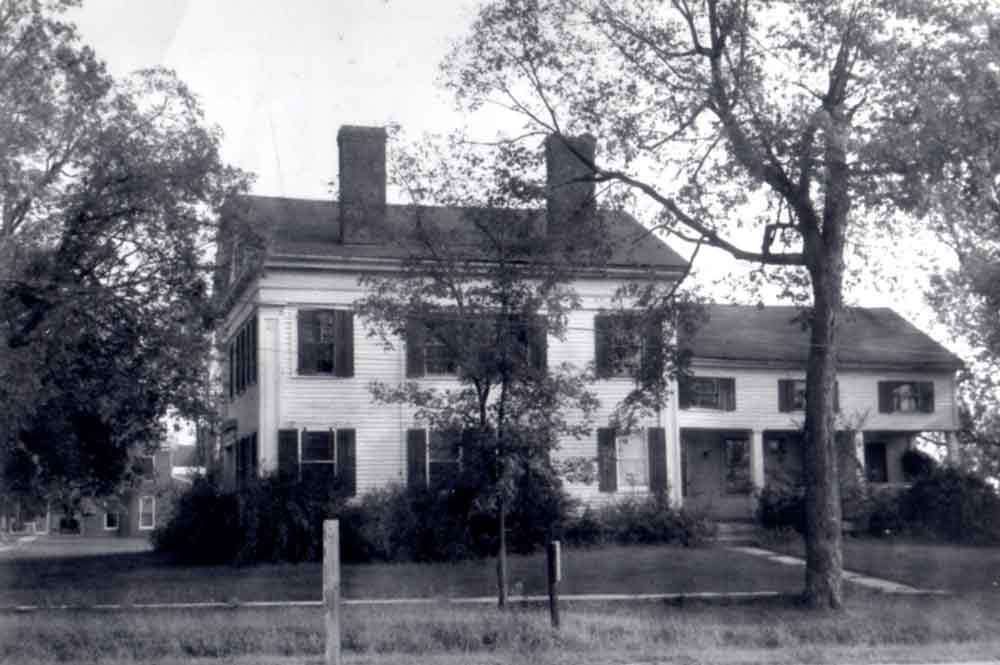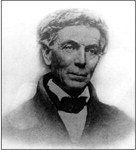Scarborough's Payson: 'Yankees' and 'Suckers'

The first half of the 19th century was a time of extensive population movement. Canals that connected the Atlantic with the Great Lakes and the Great Lakes with the Ohio and Mississippi Rivers, and Bounty Land grants in Illinois that were awarded to veterans of the War of 1812, allowed thousands of Easterners from New England to the Carolinas to head west. They left behind the traditions that they chose to abandon, and carried with them the values they hoped to pass on to future generations.
To many New Englanders, the value of putting down roots ranked very high, and community service was an expectation. Business was conducted formally, and frugality was admired. Education was worth sacrifice to achieve, and one's church and faith were integral in all parts of life. Many Southerners and new "Westerners" appreciated the opportunity to try a new place, and if it did not live up to expectations, use their freedom to try someplace else. Business could be done with a handshake, things could be borrowed instead of bought, and religion and education were private matters more than public ones.
Each had a disdainful nickname for the other: In Illinois, New Englanders called the Southern settlers "Suckers," after the Mississippi River fish that migrated seasonally and scavenged, and the Southerners called the staid and frugal New Englanders "Yankees."
John Wood of New York came to the Illinois bounty land and built a cabin on the bank of the Mississippi in 1822. Soon he began finding and showing bounty owners their property and buying up tracts in what would become Quincy and Adams County.
On April 10, 1833, in West Hartford, Conn., another young man headed toward Adams County to survey the prospects there: Albigence Scarborough, teacher, farmer, former militiaman, superintendent of the Sabbath school, and Deacon in the Congregational Church. He wanted a healthier climate and better land than New England offered, and the newly opened lands of Illinois promised both. By steamboats, trains, and stage coaches, he arrived in Quincy on May 7, 1833. With Dr. Richard Eells and two others, he rode to Rushville, and wrote to his wife, "To give a description in writing of the land I have just seen is beyond my talent, but I can say it is the best new country I was ever in." He visited Lewistown, Canton, Macomb, and Mendon before returning to Quincy. On May 27, he and John Wood rode southeast from Quincy to view available land. Then Albigence returned to Connecticut.

On June 7, 1833, John Wood rode southeast again, and with Edward Kimball and Brackett Pottle, recently arrived from New Hampshire, inspected four of the few remaining government-owned tracts left in the county. The next day the men purchased all 740 acres for $1.25 an acre.
Back East, encouraged by Dr. Eells's letters, Scarborough made the arrangements and headed west in a wagon on Sep. 1, 1834, with his wife, Electa, their children, Albigence Jr., 5, and Elizabeth, 1, and Miss Mary Woodruff. Coming through Cleveland, Columbus, Indianapolis, and Springfield, they reached Quincy on Oct.11, where they spent the winter.
But Quincy wasn't Scarborough's goal. He wrote: "I mean to buy all the choicest land as fast as it can be bot [sic]…for the purpose of keeping it out of the hands of non-residences and speculators…and let in good Yankees who are willing to come and help build up a church and society." In 1834-35, he purchased about 1500 acres about a dozen miles southeast of Quincy from ten different men, including 113 acres from John Wood for $2 an acre, and in March, 1835, platted a town.
The Scarboroughs soon occupied a log cabin northeast of the town green, and almost immediately Albigence began holding Sunday services. Settlers rode great distances to attend. Deacon Scarborough led by reading the sermons of Dr. Edward Payson of the Second Congregational Church of Portland, Maine, which were widely circulated in New England. He named his town Paysonville (soon shortened to Payson) after the preacher he admired so much.
New Englanders who had settled in the region moved to the new town: Brackett Pottle and Abner Perry from farms, Captains John Burns and Joseph Badger from Quincy. Other Yankees came: builder Jasper Whitcomb of Vermont in 1834, storekeeper David Prince of Connecticut in 1835. Charles Whitman, who built Payson's first frame house, Daniel Scarborough (Albigence's nephew), Joseph Fielding, and Martin Seymour came from West Hartford, and Philo Ellsworth Thompson from Ellington, Conn.
Thompson wrote, "This the village of Payson and as laid out seems formed by the God of nature for a town as they design it, and should building progress a few years as during the year past, it will soon be one of the pleasantest villages which this country produces." Albigence's dream of planting a typical New England community in Adams County seemed to be becoming a reality.
But the nearby settlers from elsewhere brought different ideas. Southerners Woodruff Laurence and R. F. Edmunds had arrived in 1831, P. C. Benson and K. S. Nichols in 1832, Gabriel and Robert Kay in 1833, J. C. Bernard in 1834, and others followed.
Scarborough had been more impressed with the land than the people he encountered when he first inspected the region. He had written: "It was a section of country that is quite rolling land, rich and thinly settled…it is a section that I think will be settled soon and I should like to see a church grow up formed on Christ as a cornerstone." But he also commented, "A majority of the people are indolent, ignorant, very slovenly, quite poor and live from hand to mouth without the necessities of life…in poor log cabins without much furniture and are very strongly prejudiced against the Yankees and doubly prejudiced against Presbyterians." Mary Prince, also a New Englander, later wrote, "Most of the inhabitants are from Kentucky, some are well informed -- many … can neither read [n]or write and do not think it is of much consequence to send their children to school." Nancy Scarborough wrote of visiting a family who had never lived in a house that had windows. The cabin door was left open for light year-round.
Scarborough held high ideals for his planned town and he determined not to have a public sale of the town lots, but to sell "only to men of a particular stamp …" That "stamp" was apparently educated Congregational New Englanders who intended to stay and build a community together: money from the sale of the 26 lots around the town green was designated to build a Congregational meeting house.
That was not a popular decision among his Southern neighbors, but soon the Deacon showed that he would consider differing opinions. On March 10, 1836, a meeting of Yankees and Suckers was held in his home that culminated with a resolution that "the restriction heretofore laid on the sale of the lots west of the town connecting them with the town lots be removed." When the lots were sold in August, however, only those around the green were sold, virtually all to Yankees.
Philo Thompson wrote, "There is generally in this country a strong prejudice existing between Eastern and Western people and circumstances here have rendered the Suckers highly indignant against the Yankees." By the following year the indignant group laid out a rival town one-half mile north of Payson on land owned by J. C. Bernard, formerly of Kentucky, and one of Scarborough's first acquaintances. They announced a sale of 100 lots on April 1, 1837, in "West Union." The Yankees of Payson knew two towns that close together could not both survive, and called another meeting, "as they felt anxious to do all in their power to abolish existing prejudices."
The men reached a compromise that laid the foundation for a strong future for Payson. An administrative group of both Yankees and Suckers was appointed, lots were added and resold, money was set aside for a school, and Albigence sold half interest in his unsold lots to J. C. Bernard. In addition, Deacon Scarborough personally donated the land for the school and for a cemetery.
There is evidence that Albigence Scarborough's willingness to compromise and to abandon prejudices presented a model that was followed. In 1838, the township's first postmaster, R. B. Hibbard, was from Vermont, but the first justice of the peace, Milus Gay, hailed from North Carolina and in 1850 the first township supervisor was Robert Kay, a Virginian who had come to Payson by way of Kentucky.
Linda Riggs Mayfield is a researcher, writer, and online consultant for doctoral scholars and authors. She retired from the associate faculty of Blessing-Rieman College of Nursing, and serves on the board of the Historical Society.
Sources
Genodky, Landry, ed. Peoples' History of Quincy and Adams County, Illinois: A Sesquicentennial History. Jost & Kiefer Printing, n.d.
History of Adams County, Illinois. Murray, Williamson & Phelps. 1879.
Hoskins, Linda. Personal Interview, August 1, 2014, Payson, IL.
Kay, Jean. Telephone Interview, August 5, 2014, Quincy, IL.
Rev. Edward Payson. Sermons. Retrieved from http://www.intercom.net/~hisalone/
Scarborough, Joel W. Personal Interview, August 1, 2014, Payson, IL.
Scarborough, Jared. Personal Interview, August 1, 2014, Payson, IL.
Scarborough, Joel. A History of Payson, Illinois, 1835-1865: A Study in the Settlement of the Western Illinois Frontier. Georgetown University Dissertation, 1951.
Wilcox, David F., ed. Quincy and Adams County: History and Representative Men. Lewis Publishing Company, Chicago, 1919.
Online Etymology Dictionary. Retrieved from http://www.etymonline.com/index .php?term=yankee and http://www.etymonline.com/index.php?term=sucker






